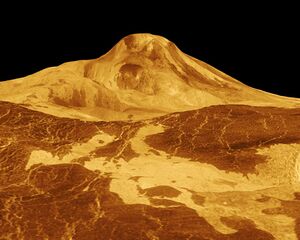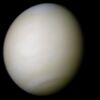Astronomy:Maat Mons
 Maat Mons is displayed in this three-dimensional perspective view of the surface of Venus, with the vertical scale multiplied by 22.5. Based on Magellan probe radar images | |
| Feature type | Mountain |
|---|---|
| Coordinates | [ ⚑ ] : 0°30′N 194°36′E / 0.5°N 194.6°E[1] |
| Diameter | 395 km (245 mi) |
| Peak |
|
| Eponym | Ma'at |
Maat Mons is a massive shield volcano on the planet Venus and the planet's second-highest mountain and highest volcano. It rises 8 kilometres (5.0 mi) above the mean planetary radius at [ ⚑ ] 0°30′N 194°36′E / 0.5°N 194.6°E, and nearly 5 km above the surrounding plains.[2] It is named after the Egyptian goddess of truth and justice, Ma'at.
Structure
Maat Mons has a large summit caldera, 28×31 km in size. Within the large caldera, there are at least five smaller collapse craters, up to 10 km in diameter.[3]
A chain of small craters 3–5 km in diameter extends some 40 km along the southeast flank of the volcano, but rather than indicating a large fissure eruption, they seem to also be formed by collapse: full resolution imagery from the Magellan probe reveals no evidence of lava flows from these craters.[3]
At least two large scale structural collapse events seem to have occurred in the past on Maat Mons.[3]
Activity
Radar sounding by the Magellan probe revealed evidence for comparatively recent volcanic activity at Maat Mons, in the form of ash flows near the summit and on the northern flank.[4]
Intriguingly for planetary geologists, atmospheric studies carried out by the Pioneer Venus probes in the early 1980s revealed a considerable variation in the concentrations of sulfur dioxide (SO2) and methane (CH4) in Venus' middle and upper atmosphere. One possible explanation for this was the injection of volcanic gases into the atmosphere by plinian eruptions at Maat Mons.[5]
More recent studies have suggested that the volcano structure, distribution of lava flows, pit craters, summit morphology, and other small-scale features are indicative of recent volcanic activity on Maat Mons.[6]
A study published by the journal Science in 2023 concluded that there has been recent volcanic activity on Maat Mons. The study analyzed images taken between 1990 and 1992 by the Magellan spacecraft. These images, taken eight months apart, displayed changes to the volcanic vent's shape and dramatically increased in size.[7] The image also showed what scientists interpreted as lava flows.[8]
See also
- List of montes on Venus
- Volcanism on Venus
References
- ↑ "Maat Mons". Gazetteer of Planetary Nomenclature. USGS Astrogeology Research Program.
- ↑ "PIA00106: Venus - 3D Perspective View of Maat Mons". Planetary Photojournal. Jet Propulsion Lab. 1996-08-01. http://photojournal.jpl.nasa.gov/catalog/PIA00106.
- ↑ 3.0 3.1 3.2 Mouginis-Mark P. J. (1994). "Morphology of Venus Calderas: Sif and Maat Montes". Abstracts of the 25th Lunar and Planetary Science Conference, Held in Houston, TX, 14–18 March 1994: 949. Bibcode: 1994LPI....25..949M. http://www.lpi.usra.edu/meetings/lpsc1994/pdf/1475.pdf.
- ↑ Volcanoes on Venus? ‘Striking’ finding hints at modern-day activity. Nature News, 15 March 2023
- ↑ Robinson, Cordula A.; Thornhill, Gill D.; Parfitt, Elisabeth A. (1995). "Large-scale volcanic activity at Maat Mons: Can this explain fluctuations in atmospheric chemistry observed by Pioneer Venus?". Journal of Geophysical Research 100 (E6): 11755–11763. doi:10.1029/95JE00147. Bibcode: 1995JGR...10011755R.
- ↑ Mouginis-Mark, Peter J. (2016-10-01). "Geomorphology and volcanology of Maat Mons, Venus". Icarus 277: 433–441. doi:10.1016/j.icarus.2016.05.022. Bibcode: 2016Icar..277..433M.
- ↑ Valero, Myriam Vidal (15 March 2023). "Volcanoes on Venus? ‘Striking’ finding hints at modern-day activity". Nature 615: 567-568. doi:10.1038/d41586-023-00783-x.
- ↑ Herrick, Robert R.; Hensley, Scott (2023). "Surface changes observed on a Venusian volcano during the Magellan mission". Science 379: 1205–1208. doi:10.1126/science.abm7735.
External links
 |


